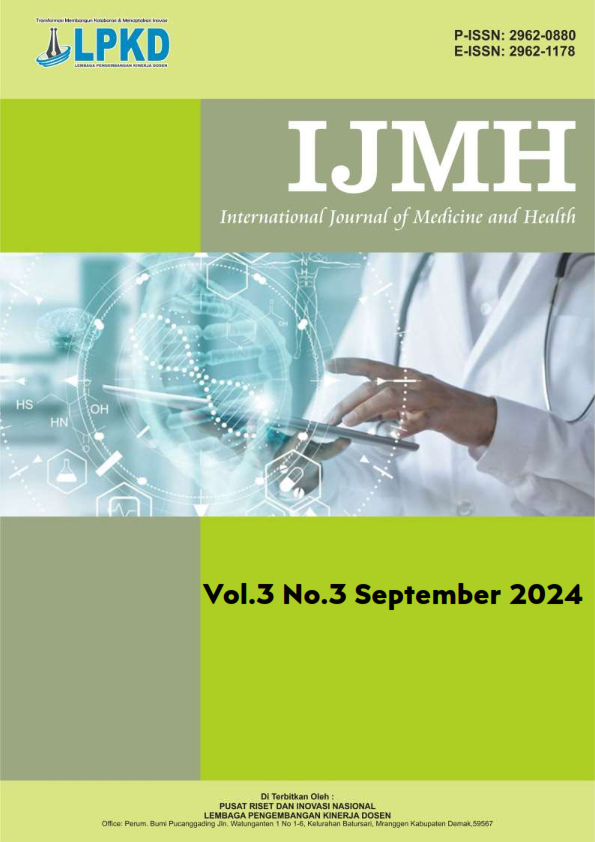Relationship Between Knowledge of the Role of Motivation and Work Period of Posyandu Cadres Towards the Use of Anthropometric Devices at UPTD Puskesmas Topo
DOI:
https://doi.org/10.55606/ijmh.v3i3.4448Keywords:
Anthropometry, Length of Service, Motivation, Knowledge, Role of CadresAbstract
Anthropometry is a direct technique for evaluatingnutritional status, especially protein and energy levels of the body. One of the efforts to develop competent and skilled cadres in anthropometric measurements is through training techniques. To determine the relationship between knowledge, role, motivation and length of service of Posyandu cadres towards the use of anthropometric tools at the Topo Health Center UPTD.Method:This type of research is observational analytic using Cross Sectional Study. The research sample amounted to 30 cadres from 3 active posyandu. Data analysis used the Statistical Program For Social Science (SPSS) version 16.0.Results:Chi Square Testshows that there is no relationship between cadre knowledge and the use of anthropometric tools based on the measurement of the foot scale and stadiometer (p-value> 0.05). There is a relationship between cadre knowledge and the use of anthropometric tools based on the measurement ofLiLa, infantometer, and head circumference (p-value <0.05). While the relationship between work period and the use of anthropometric tools and the relationship between motivation and the use of anthropometric tools is not related (p-value> 0.05). Conclusion: There is a significant relationship between cadre knowledge and the use of anthropometric tools (measurement ofLiLa, infantometer, and head circumference). There is no significant relationship between work period and the use of anthropometric tools, as well as motivation and the use of anthropometric tools. Suggestion: it is hoped that cadre training will be held frequently and will be improved and more active in using anthropometric tools.
References
Afifa, I. (2019). The Role of Cadres in Preventing Stunting: The Role of Length of Service as a Cadre, Knowledge and Motivation. Brawijaya Medical Journal, 30(4), 336-341.
Al Malik, RH, & Darwis, N. (2020). The Relationship of Motivation to the Role of Posyandu Cadres in the Panyili Health Center Work Area, Palakka District, Bone Regency. Mappadising Scientific Journal, 2(2), 113-122.
Al-faida, N. (2023). Nutrition Research Methodology. PT Nasya Ekspanding Management. Central Java.
Azizah, AN (2023a). Anthropometric Measurement Training as Early Detection of Stunting. Proceedings of the National Seminar of Lppm Ump.
Fitriani, A., & Purwaningtyas, DR (2020). Improving Knowledge and Skills of Posyandu Cadres in Anthropometric Measurements in Cilandak Barat Village, South Jakarta. Solma Journal, 9(2), 367-378.
Herdian, A. (2021). Baby Head Circumference Measurement Tool Based on the Ellipse Circle Method (Doctoral dissertation, Sultan Agung Islamic University (Indonesia).
Iwandana, DT (2023). Analysis of the relationship between anthropometry and boxing athlete punching ability. Multilateral: Journal of Physical Education and Sports, 22(4), 11-18.
Janwarin, LM (2020). The Relationship between Knowledge and Motivation with the Activeness of Posyandu Cadres. Moluccas Health Journal, 2(2).
Kamba, I., Ratno, R., Ningsih, S., & Arwan, A. (2021). The Relationship between Motivation and the Activeness of Posyandu Cadres in the Gunung Tabur Health Center Working Area in 2020. Preventif: Journal of Public Health, 12(2), 378-378.
Kasumayanti, E., Aprilla, N., & Hotna, S. (2022). Description of Cadre Motivation in Providing Posyandu Services in Bukit Kemuning Village, Sukaramai Health Center UPT Work Area in 2021. Jurnal Ners, 6(1), 75-79.
Makbul, M. (2021). Data Collection Methods and Research Instruments. Alaudin State Islamic University Makassar.
Mimi, RTJ, & Usman, U. (2021). Analysis of the Level of Knowledge of Posyandu Cadres in Anthropometric Measurements to Prevent Stunting in the Work Area of the Lapadde Health Center, Parepare City. Scientific Journal of Humans and Health, 4(2), 279-286.
Mulyati, S. (2021). The Relationship between Parental Income and Student Learning Achievement in the Islamic Community Development Department (PMI), Faculty of Da'wah and Communication, Ar-Raniry State Islamic University, Banda Aceh (Doctoral dissertation, UIN Ar-Raniry).
Nabire District Health Office (2023). Target Population Data for Nutrition and KIA Programs of Nabire District Health Office. Nabire: Central Papua.
Naomi, I., & Budiono, I. (2022). The Effect of Providing Anthropometric Training on the Knowledge of Posyandu Cadres. Indonesian Journal of Public Health and Nutrition, 2(2), 171-177.
Noorhidayah, N., Asrinawaty, A., & Zam, MZ (2017). The Relationship between Training and Motivation with the Activeness of Cadres in the Implementation of Posyandu Activities in the Teluk Tiram Banjarmasin Health Center Working Area. Health Dynamics: Journal of Midwifery and Nursing, 8(1), 130-138.
Puspita, ID, & Amar, MI (2018). Refreshing Posyandu cadres with training on anthropometric measurements and nutritional status assessment in the Sukmajaya Health Center UPT area. In National Seminar on Community Service Results (Vol. 1, No. 1).
Research and Development Agency of the Indonesian Ministry of Health (2013). Basic Health Research 2013; RISKESDAS. Jakarta: Research and Development Agency of the Indonesian Ministry of Health; 2013.
Retnowati, L., & Pujiastuti, N. (2022). Motivation and Role of Posyandu Cadres (Literature Review Study). Majapahit Hospital (Health Scientific Journal of Majapahit Health Polytechnic Mojokerto), 14(2), 231-237.
Sugiyono. (2019). Quantitative, Qualitative, and R&D Research Methodology. Alfabeta. Bandung.
Sundari, SW, Windiyani, W., Nuryuniarti, R., & Sagita, M. (2020). Skills Improvement Training for Mulyasari Integrated Health Post Cadres, Tamansari, Tasikmalaya City. Journal of Community Service, 5(3), 768-774.
Topo Health Center UPTD (2024). Population Target Data for Nutrition and KIA Programs of Topo Health Center UPTD. Nabire.
Usman, U., & Rusman, ADP (2022). Analysis of the Performance of Posyandu Cadres in Anthropometric Measurements in the City of Parepare. Scientific Journal of Humans and Health, 5(1), 487-493.
WWorld Health Organization. 2013. Childhood Stunting: Challenges and Opportunities. Switzerland: Department of Nutrition for Health and Development. www.who.int. (Accessed 5 February 2024)
Yasirah, Y., Asniar, A., & Satria, B. (2023). Health Cadre Training on Balanced Nutrition and Toddler Anthropometric Measurements: A Case Study. Scientific Journal of Nursing Faculty Students, 7(3).
Downloads
Published
Issue
Section
License
Copyright (c) 2024 International Journal of Medicine and Health

This work is licensed under a Creative Commons Attribution-ShareAlike 4.0 International License.






